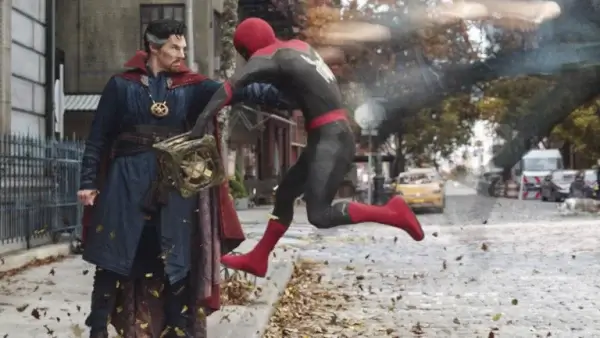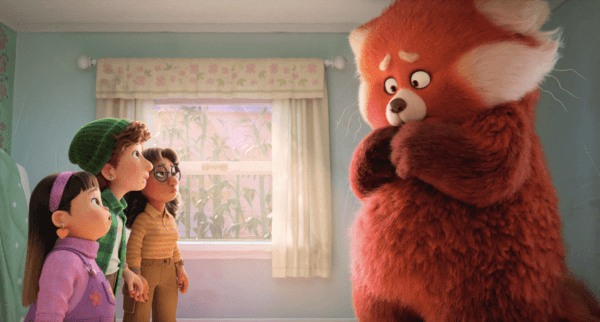Turning Red: What is Worthy of Cinema?
Few animation studios are celebrated as much as Pixar, each release being an event within the realm of animation. However, the pandemic has shifted the scale of these Pixar event films. Both of the animation house’s movies since the start of the pandemic, Soul and Luca, have been straight-to-streaming drops with the upcoming Turning Red recently announced to follow suit.

Turning Red (© 2021 Disney/Pixar. All Rights Reserved.)
This news follows a year where Pixar’s parent company, Disney, gave cinematic releases to 19 projects from other arms of the company such as Marvel and Searchlight. Praise and criticism have arrived in equal parts in response to this move. Though many believe it to be wrong for Disney to convert this acclaimed studio into a sales tool, leading consumers to their streaming service, others see it as putting fan convenience first. But separating films into cinematic and streaming releases creates the idea that the latter lot are inferior.
A Singular Experience
Many of the reasons behind Disney’s distribution of Turning Red are circumstantial with much of the backlash coming from a previous stigma from straight-to-tv or direct-to-dvd or video movies. If not for the pandemic and rapidly developing home cinema technology, the gap between experiencing a film in a theatre versus watching one at home would still be a chasm. We no longer have tiny TV sets with grainy video versions of big screen classics playing fuzzily at the other end of the room, these days the average home media setup is a large HD smart TV with the latest sound technology, enjoyed by people who are actively encouraged to not leave the house. Attitudes towards the ‘correct’ way to view a movie are softening.
Though, it’s difficult to not be cynical about the true intentions of a company like Disney. Consumer-first policies are designed to offer the audience a breadth of choice but Disney have unnecessarily funnelled Turning Red’s entire audience through their streaming service. As convenient as it is for those who are unnerved by the idea of going to the cinema, it rips an option away from those who are not, all for the sake of driving up subscriptions.

Encanto saw both healthy box office returns, and streaming fan reaction for Disney (© 2021 Disney. All Rights Reserved.)
That subscription model is dear to Disney, especially through the pandemic where box office returns have been diminished across the board but for a few exceptions. Clearly, Disney have been reluctant to take a chance on Pixar’s output being one of those exceptions. Pixar make family movies, and some may deem parents less likely to get the family together for a cinema trip, but this refuses to line up with Disney’s treatment of Encanto. The decision to send Turning Red to Disney+ came after Encanto recouped $216 million at the box office, a figure that pales in comparison to pre-pandemic numbers. Disney may have lost faith in the audience’s willingness to see an animated movie in droves. Equally important is the outpouring of love on social media for Encanto following its Christmas Eve Disney+ release, yet fans were still given the option of a cinematic viewing. The elephant in the box office, however, is likely to be the largest driving force in the minds of Disney execs – Marvel.

Spider-Man No Way Home (Sony 2021)
When discussing exceptions in Hollywood, Marvel is typically the topic. 2021 saw Marvel achieve the second biggest opening weekend of all time and break past labour day weekend records in the middle of a pandemic. Familiarity mixed with the right amount of chaos and unpredictability is what Marvel offers cinema goers. Having the most recognisable characters on the planet in your back pocket and the monetary backing to tell epic sagas allows Marvel to create cinematic events on a larger scale than any other studio.
The effect of long-running franchise events is also clear in the figures of the latest James Bond film which, while not quite reaching pre-pandemic numbers, rises above the majority of releases this year by recouping more than $800 million. Thus, you might forgive a finance obsessed suit to not have faith in a non-franchise movie about a girl who turns into a red panda becoming a box office hit. Distribution through a streaming service is cheaper and is likely to reach a wider audience. However, such a mentality discolours the future of cinemas as an institution, narrowing the scope of what’s possible inside that building, forcing assimilation upon creators who want people to experience their film in the optimal way.
What Does Turning Red Have To Prove?
One may determine the worth of a film through the lens of the criticism or praise it receives in reviews, but Disney’s decision with Turning Red picks at a perceived fault of its mere conception. Forging such an arbitrary barrier between what is and what is not cinematic puts a mark of inferiority on anything that is not gunning for Avengers: Endgame. Ironically, on the horizon sits Lightyear, a Pixar product which adds to a beloved franchise spanning almost three decades.

Will Lightyear see Pixar return to Cinema? (© 2021 Disney/Pixar. All Rights Reserved.)
Lightyear seems ripe for cinema consumption but is likely to receive a significant promotional push. In other words, it is going to be built up to be the event which Turning Red has yet to be given. Marvel are successful because they put in the effort to make every one of their products feel like an event, they put the promotional work in. Increasingly, Disney give off the impression that they lack faith in Turning Red and Pixar’s other non-franchise creations leaving fans and even their own staff disgruntled. By not offering at least the option of a cinematic release, Disney have potentially hampered the success of their movie.

Turning Red (© 2021 Disney/Pixar. All Rights Reserved.)
The way in which we experience our films is changing. A once temporary, pandemic-combative measure is feeling worryingly permanent, worrying not only for the personal desire to see a colourful, fun movie in the cinema, but for the spectrum of creativity that cinema offers. For years this mindset has seeped into the thoughts of casual audiences, it now being normal to segregate which movies are worth going to the cinema for. There was a time where the cinema itself was a mystery box, where part of the thrill was gambling a tenner on a movie about talking toys made by an unknown studio being great, or a tale of a lost fish making you cry. Opening yourself up to the range of experiences which all film had to offer is a huge part of why cinemas have felt like institutions, and setting audiences down a pre-programmed path is reductive to what cinema stands for. This may sound like the whining of a purist, but for the sake of creators, animators and all film lovers, I pray for the downfall of the homogeneity of cinema.

